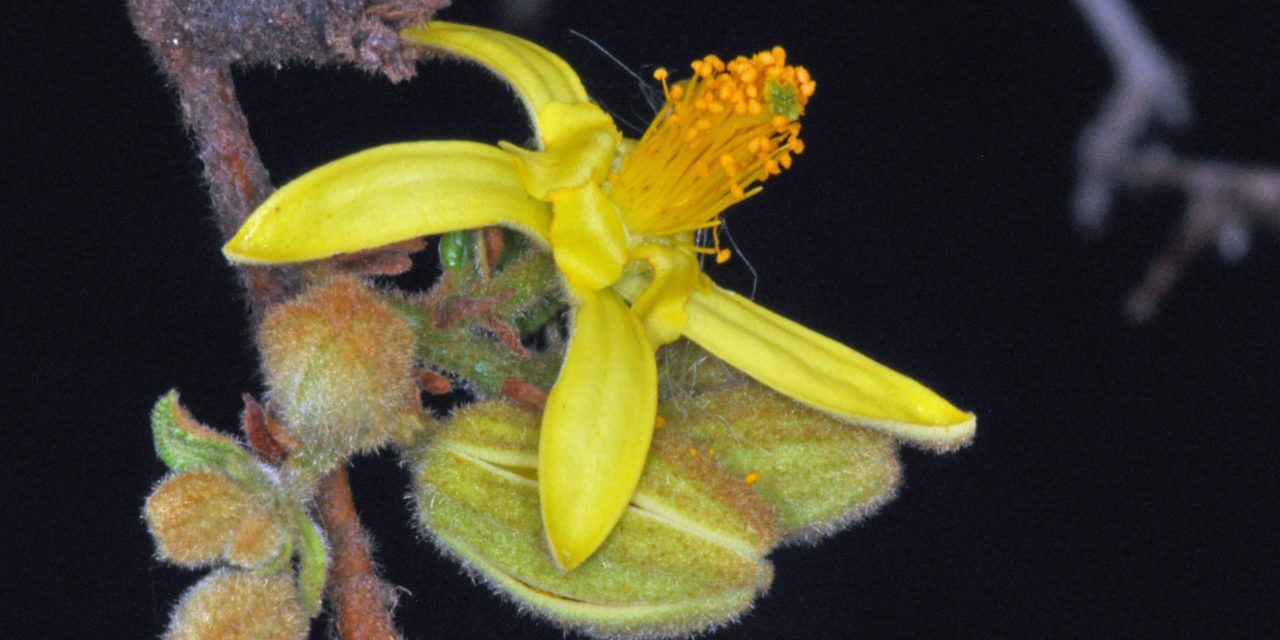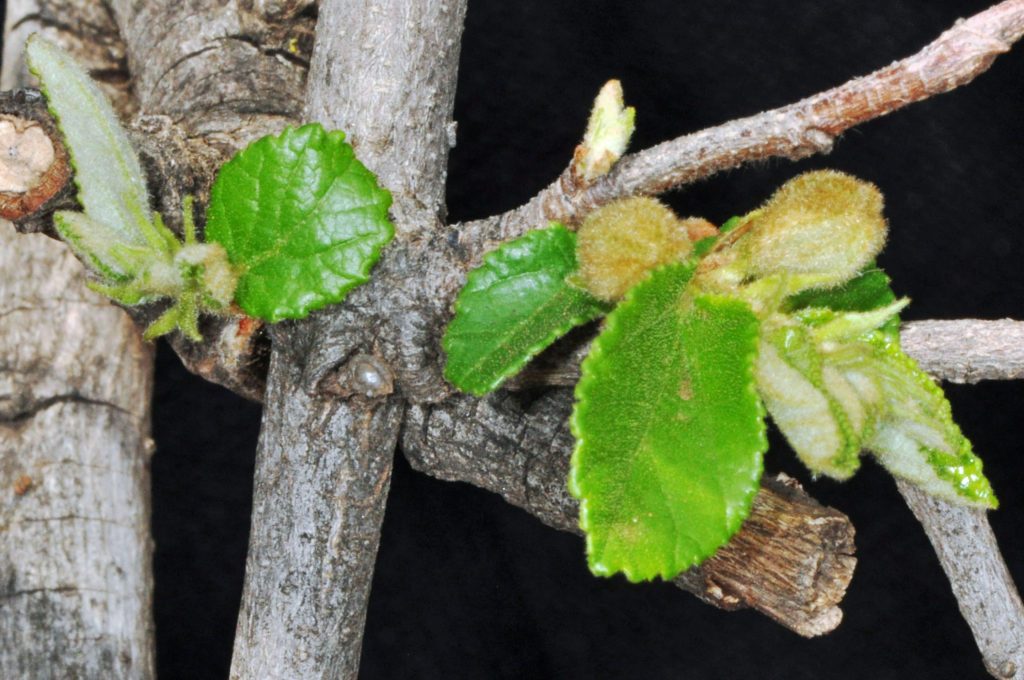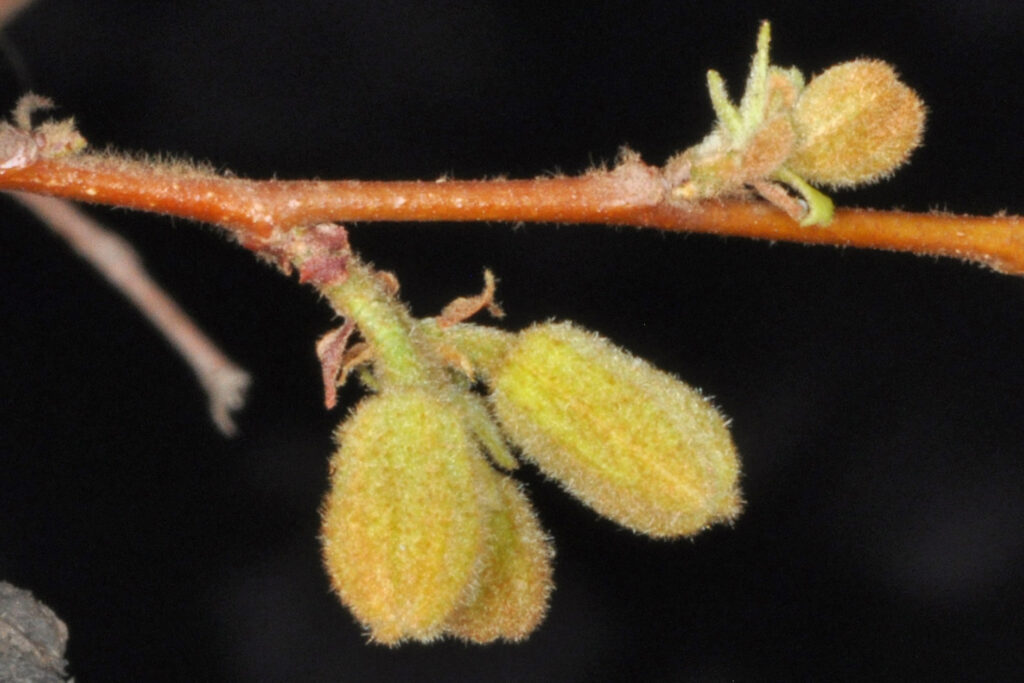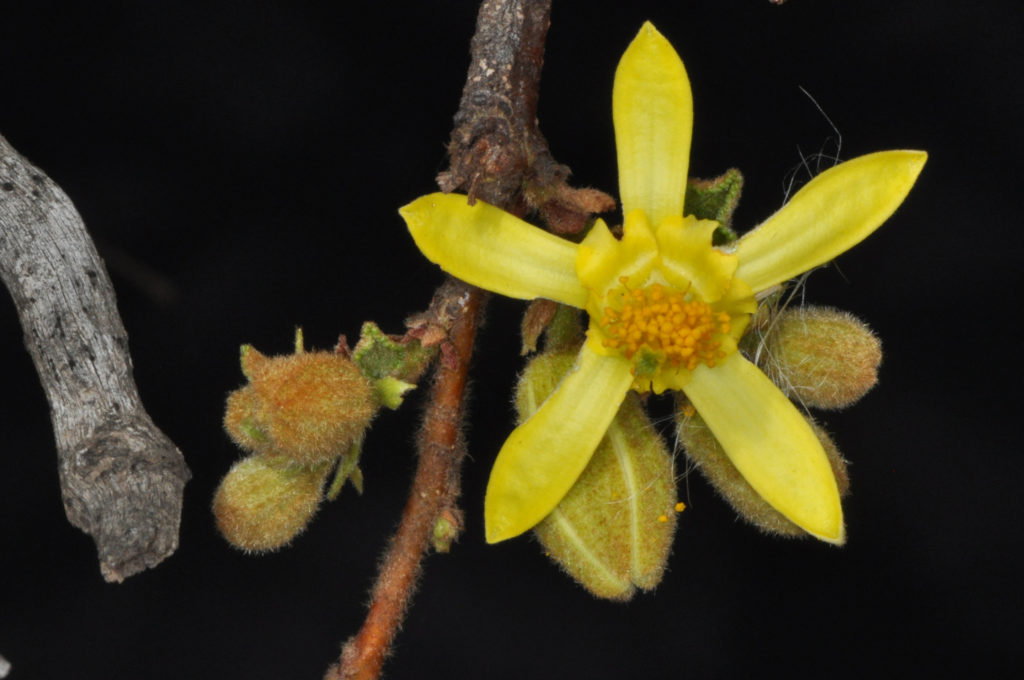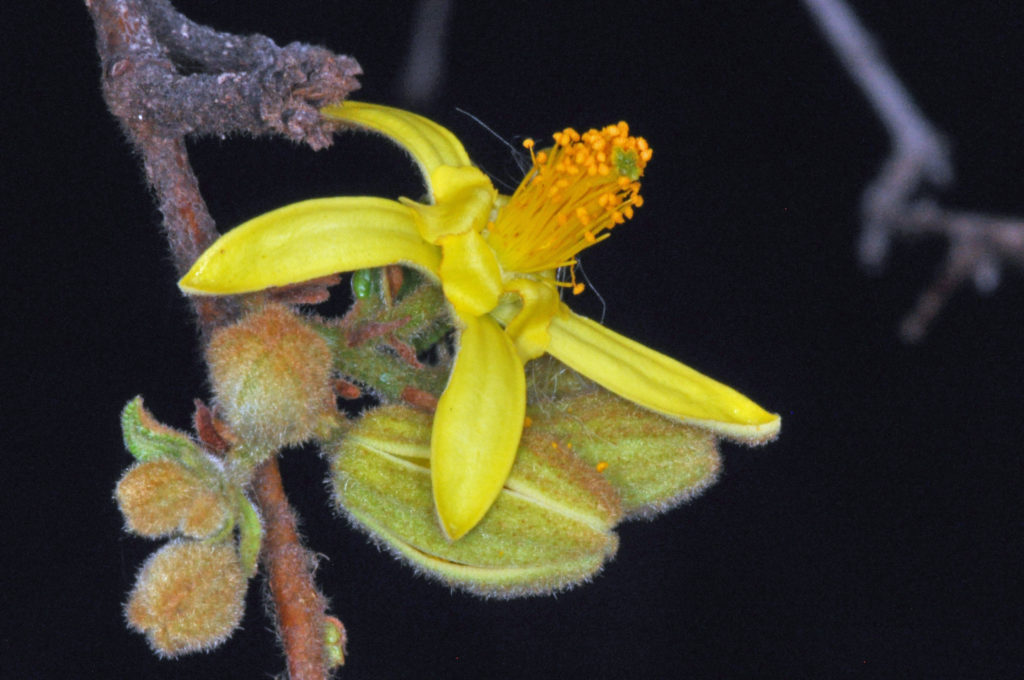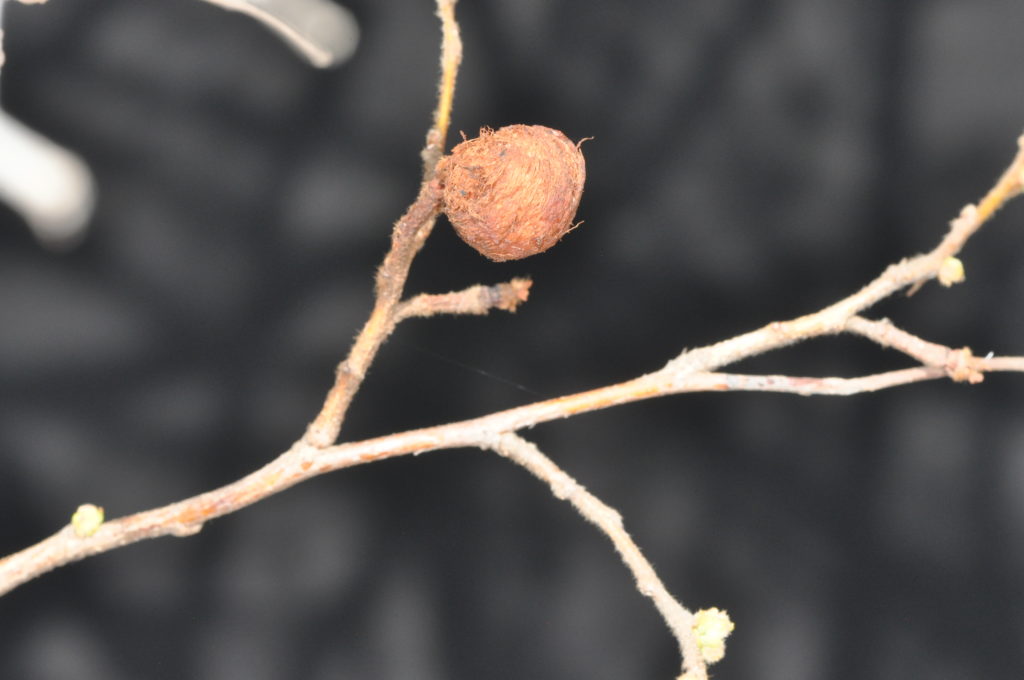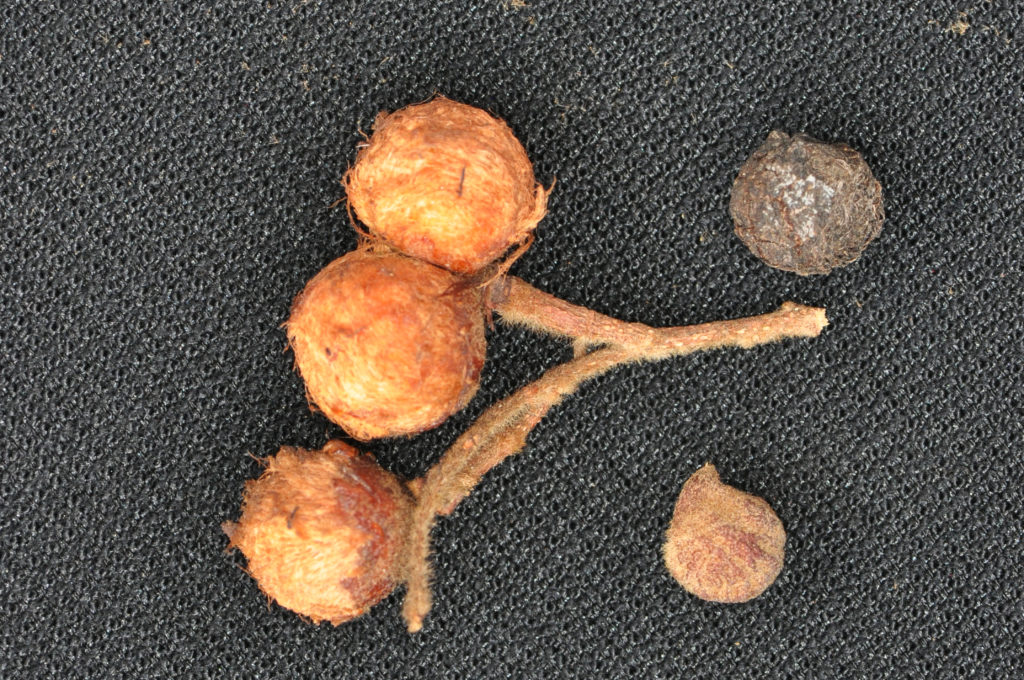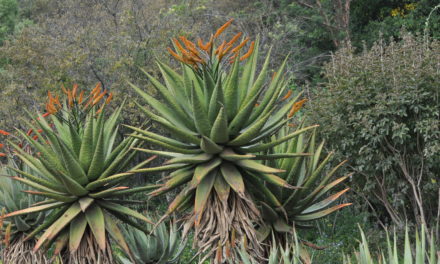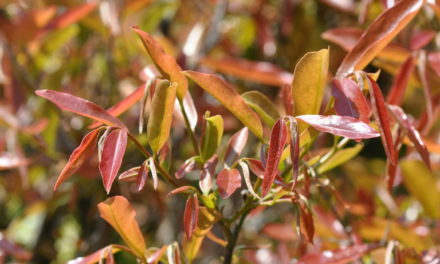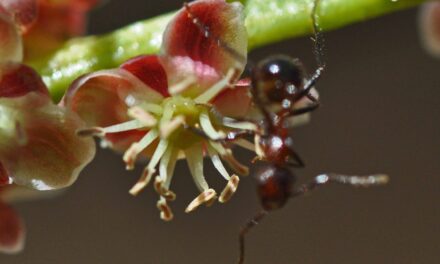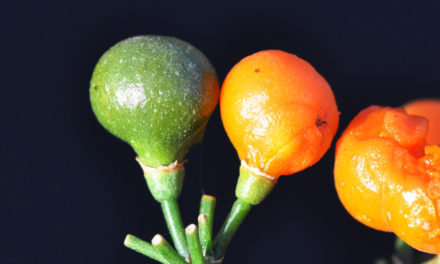General Info – summary
This deciduous Tree up to 8m high has smooth reddish brown/grey bark. Alternate, simple, serrated Leaves are 3-veined from the asymmetric base. Golden yellow, bisexual, 5-merous, regular Flowers have large bi-coloured sepals and short yellow petals. The many filaments are orange. The single pistil has a superior ovary and an extended stigma. Fruit is a small, indehiscent drupe with animal dispersed seeds.
Description
Grewia hexamita
Previous Names: Grewia schweickerdtii, Grewia messinica.
SA Tree No. 460.
Common names: (Afr) Reuserosyntjie. (Eng) Giant Grewia, Giant raisin, Lowveld Grewia. (isiZulu) Indliwampunzi, Umlalampunzi. (siSwati) Umsipane. (Xitsonga) Nsihana, Nsihani.
Family: Malvaceae. (Wild Pear, Gossypium – cotton, baobab and Hibiscus). This family has about 240 genera and 4 200+ species. Indigenous genera that have trees on this website includes Adansonia (baobab), Cola, Dombeya, Grewia, Hibiscus, Sparrmannia and Sterculia. The usually alternate Leaves of all members possess stipules and apart from Adansonia, remain simple. Flowers are regular, bisexual or unisexual and have 5 petals (Sparrmannia africana has 4). Petals are absent in Cola and Sterculia. There are 5 to many stamens with filaments often united into a staminal tube. Stamens surround the superior Ovary with its simple Style and capitate or lobed Stigma. Fruits are usually nuts, schizocarps or loculicidal capsules.
Name derivation: Grewia – named after the Englishman Nehemiah Grew – (1641- 1712). He was a physiologist and pioneer plant anatomist and was known as the “Father of Plant Anatomy.” hexamita – hexa 6, and mita – a thread. Reasoning unclear. There are 27 species of the genus Grewia in the South Africa.
Conservation: National Status: L C. (Least Concern). Assessed: 2005 (W. Foden and L. Potter).
Tree
This plant may be a shrub or a leafy, glossy crowned deciduous Tree up to 5m high. The crooked trunk has slightly rough and grey Bark (photo 992 – under Leaves). The tree is widely branched, and young branches initially have rusty woolly hairs. These are soon lost, exposing the orange to red bark (photo 989 – under Flowers). Here, small, slightly protruding pale Lenticels (usually raised corky, oval or elongated areas on the plant that allows the uncontrolled interchange of gases with the environment) are visible.
Leaves
The alternatively arranged, leathery and relatively large Leaves are deciduous (falling off at maturity / loss of leaves for part of the year – induced by either temperature drop, or water shortage. The process is abscission). Up to seven pairs of side Veins help generate the overall grey-white colour. Leaves are 3-veined from the Base and up to 12 x 7cm but usually smaller. The markedly asymmetric base may be lobed on one side and tapering on the other. The slightly, rough and wrinkled Blade is discolorous (having upper and lower surfaces of leaves different colours). The hairless upper surface is a noticeable rough and a shiny deep green (photo 992) colour. Dense yellowish hairs cover the whitish grey lower surface. This and longer reddish brown hairs are present. Leaves are dark glossy green above but lighter and hairy below. Each oval, ovate (egg-shaped) or elliptic leaf is simple (has a single blade which may have incisions that are not deep enough to divide the blade into leaflets). The Apex usually tapers or is rounded or flat. These veins may be more conspicuous below. The Margins are slightly rolled under and are serrate (saw-toothed margin with teeth pointing forward – photo 992). The hairy Petioles (leaf stalks) are short: up to 6mm long. Stipules (basal appendages of the petiole) are present.
- 992. 2016/10/18. Pretoria NBG. Photo: David Becking.
Flowers
The golden yellow, bisexual and 5-merous Flowers are up to 3cm long and 5cm in diameter (photo 989) and may occur in profusion. From 1-4 attractive flowers, develop together at the ends of branches and in leaf axils. Flowers are actinomorphic (Regular, symmetrical. These flowers are vertically divisible into similar halves by more than 1 plane passing through the axis). Each Pedicel (stalk of single flower – photo 989) is up to 1,5cm long. The honey-scented flowers develop from hairy buds that are green or reddish (photo 984). Before opening, they become elongated (photo 988). Flowers appear singly, or up to 4 are arranged in small Cymes (broad, more or less flat-topped, determinate flower cluster, with central flowers opening first). The outer Calyx has Sepals that are much longer than the Petals in the Corolla (photo 988). Externally the greenish red sepals (buds in photo 989) are smooth with soft stellate hair. Internally the sepals are hairless, bright yellow and, from this vantage point (photo 984), they strongly resemble petals. Sepals are up to 2,6cm long and are much larger than the petals. The 5 yellow, folded over Petals are much smaller and less visible than sepals (photo 988). Each petal is up to 7mm long. There are numerous free Stamens, with orange Filaments (photo 988). Stamens arise from an extended Receptacle (is that expanded tip of the flower stalk from which the floral parts develop). There is a single Pistil (a unit of the Gynoecium, the female element of the flower, composed of the Ovary, Style and Stigma) and the Ovary is superior. The single Style is longer than the ovary, extends just beyond the stamens and ends in a green-lobed Stigma (photo 988). (Sep-Dec).
- 989. 2016/10/18. Pretoria NBG. Photo: David Becking.
- 984. 2016/10/18. Pretoria NBG. Photo: David Becking.
- 988. 2016/10/18. Pretoria NBG. Photo: David Becking.
Fruit
The initially green Fruit matures into hairy, yellowish or reddish small single or double Drupes (a drupe is a fleshy, 1-seeded indehiscent fruit with the seed enclosed in a stony endocarp; stone fruit e.g., peach – photo 991). Drupes are up to 2cm wide when mature (photo 994). Each contains a Pyrene (nutlet in a drupe – like a peach pip). The fruit may become reddish and shiny. The Seeds are animal Dispersed. (Dec-Mar).
- 991. 2016/10/18. Pretoria NBG. Photo: David Becking.
- 994. 2016/10/18. Pretoria NBG. Photo: David Becking.
Distribution & Ecology
These plants occur naturally in northern KwaZulu-Natal, Northern Gauteng, Limpopo, Mpumalanga, Swaziland, southern Mozambique, and from Zimbabwe to Tanzania. The trees occur in deciduous woodland and in valleys at low altitudes. They are common on termite mounds and close to rivers. A number are visible in Limpopo and Komati River valleys. The plant is frost and drought resistant and grows in both sandy and clay soils. Bigger birds like Franklins and Guineafowl consume the Fruit. Other animals that eat the fruit include Baboons, Elephant (favourite food), Giraffe, Kudu, Monkeys and Warthogs.
Ethnobotany
Leaves are browsed by stock. The grey-brown Wood is relatively dense, hard, and durable. The heartwood is like ebony. The shallow fleshy layer of the Fruit is edible. This plant is a good garden prospect for temperate climates and summer rainfall areas. Seeds that have passed through animals tend to germinate more easily. Also used for propagation are Truncheons – stem cutting from a selected plant – used to produce genetically identical new plants. Impressive Flowers and Fruit develop after about 2 years.
References
Boon, R. 2010. Pooley’s Trees of eastern South Africa. Flora and Fauna Publications Trust, Durban.
Burrows, J.E., Burrows, S.M., Lotter, M.C. & Schmidt, E. 2018. Trees and Shrubs Mozambique. Publishing Print Matters (Pty) Ltd. Noordhoek, Cape Town.
Coates Palgrave, M. 2002. Keith Coates Palgrave Trees of Southern Africa. edn 3. Struik, Cape Town.
Foden, W. & Potter, L. 2005. Grewia hexamita Burret. National Assessment: Red List of South African Plants version 2020.1. Accessed on 2023/07/07.
Lawrence, G. H. M, 1951. Taxonomy of Vascular Plants. The Macmillan Company, New York. Tenth Printing 1965.
Palmer, E. & Pitman, N. 1972. Trees of southern Africa. Balkema, Amsterdam, Cape Town.
Schmidt, S. Lotter, M. & McCleland, W. 2002. Trees and Shrubs of Mpumalanga and the Kruger National Park. Jacana, Johannesburg.
van Wyk, B. & van Wyk, P. 1997 Field guide to Trees of Southern Africa. Struik, Cape Town.
http://redlist.sanbi.org/species.php?species=933-16
http://pza.sanbi.org/grewia-hexamita
http://www.zimbabweflora.co.zw/speciesdata/species.php?species_id=138480
http://iscantree.co.za/grewia-hexamita-reuse-rosyntjie-giant-raisin/
http://www.ispotnature.org/species-dictionaries/sanbi/Grewia%20hexamita
http://posa.sanbi.org/flora/browse.php?src=SP
https://www.britannica.com/plant/Melianthaceae
https://en.wikipedia.org/wiki/Melianthaceae

